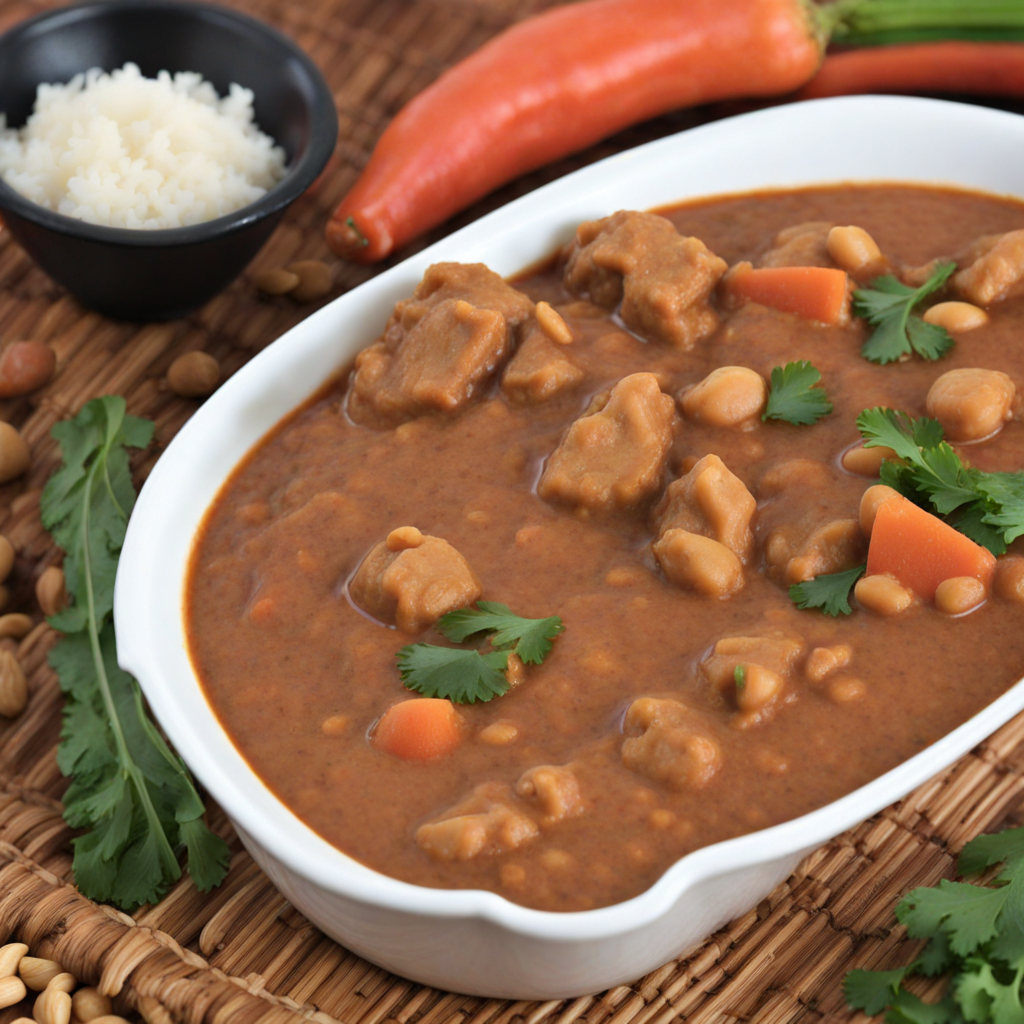Groundnut Stew
Groundnut Stew, a beloved dish from Sierra Leone, showcases the rich flavors and culinary traditions of West Africa. At its core, this hearty stew is made with groundnuts, also known as peanuts, which are ground into a smooth paste that serves as the base for the dish. The groundnuts impart a creamy texture and a nutty flavor that harmonizes beautifully with the other ingredients. The stew is often enriched with a variety of vegetables, such as sweet potatoes, carrots, and leafy greens, all simmered together to create a nourishing and satisfying meal. In addition to the groundnuts and vegetables, Groundnut Stew often features protein sources such as chicken, beef, or fish, which add depth and richness to the dish. The proteins are typically marinated with a blend of spices, including ginger, garlic, and chili, infusing the stew with an aromatic complexity that tantalizes the taste buds. As the stew cooks, the ingredients meld together, creating a symphony of flavors that is both comforting and invigorating. The delightful combination of savory and subtly sweet notes makes each spoonful a delightful experience. Traditionally served over a bed of rice, Groundnut Stew is not just a meal; it is a celebration of community and culture. The dish is often enjoyed during gatherings and special occasions, bringing people together to savor its rich heritage. With its inviting aroma and vibrant colors, Groundnut Stew invites you to explore the warm and welcoming culinary landscape of Sierra Leone, offering a taste that is both unique and unforgettable.
How It Became This Dish
The Rich History of Groundnut Soup in Sierra Leone Groundnut soup, also known as peanut soup, holds a cherished place in the culinary heritage of Sierra Leone. This hearty dish, characterized by its creamy texture and rich flavors, not only nourishes the body but also embodies the cultural essence of the Sierra Leonean people. Its origins, significance in daily life, and evolution over the years provide a fascinating glimpse into the intersection of culture, agriculture, and gastronomy in this West African nation. #### Origins of Groundnut Soup Groundnuts, or peanuts, are native to South America, where they were cultivated by ancient civilizations. It is believed that they traveled to Africa through the transatlantic slave trade and trade routes, becoming an integral crop in various regions. By the 19th century, peanuts were widely cultivated in West Africa, including Sierra Leone, where they thrived in the region's warm climate and fertile soil. Groundnut soup likely emerged as a practical and nourishing dish, making use of the abundant local ingredients. The primary ingredient, groundnuts, were ground into a paste to create a flavorful base for the soup. This paste, combined with water, meat, and various vegetables, transformed into a comforting meal that was both filling and economical. The soup was originally prepared to sustain families, especially during the harsh dry seasons when food was scarce. #### Cultural Significance In Sierra Leone, food is more than just sustenance; it is a vital part of cultural identity and social cohesion. Groundnut soup is often prepared during communal gatherings, celebrations, and events, symbolizing hospitality and togetherness. The dish is typically served with rice, fufu, or cassava, making it a central part of traditional meals. The preparation of groundnut soup often involves the entire family, from grinding the peanuts to chopping vegetables, fostering a sense of unity and cooperation. This communal aspect of cooking reinforces familial bonds and cultural traditions, as recipes are often passed down through generations. The act of sharing food, particularly groundnut soup, is a way of expressing love, gratitude, and solidarity within communities. Moreover, groundnut soup is often associated with special occasions such as weddings, naming ceremonies, and public feasts. During these events, the dish serves as a symbol of abundance and wealth, showcasing the host's generosity. Its rich flavor and satisfying nature make it a beloved dish among both locals and visitors alike. #### Development Over Time As Sierra Leone's culinary landscape has evolved, so too has groundnut soup. Traditionally, the soup was prepared using locally sourced, seasonal ingredients, reflecting the agricultural practices of the time. However, with globalization and the influence of modern cooking techniques, variations of the dish have emerged. In urban areas, the incorporation of new ingredients such as coconut milk, tomatoes, and spices has transformed the traditional recipe into a more contemporary version. Additionally, the rise of international cuisine has introduced new flavors and cooking methods, allowing for a fusion of traditional and modern culinary practices. These innovations have made groundnut soup more accessible to a wider audience, both within Sierra Leone and beyond. The impact of Sierra Leone's civil war (1991-2002) on food culture should not be overlooked. The conflict disrupted agricultural production and displaced communities, leading to changes in food availability and preparation methods. Many families were forced to adapt their recipes, often using whatever ingredients were available. This adaptability is a testament to the resilience of the Sierra Leonean people, as they found ways to continue their culinary traditions amidst hardship. #### Modern Recognition and Global Influence In recent years, groundnut soup has gained international recognition as part of the broader movement to celebrate African cuisine. Chefs and food enthusiasts around the world have begun to explore and showcase traditional dishes like groundnut soup, highlighting their unique flavors and cultural significance. This growing interest has led to increased demand for authentic West African recipes and ingredients, allowing Sierra Leonean culinary traditions to reach a global audience. Furthermore, the rise of social media and food blogs has played a significant role in popularizing groundnut soup. Home cooks and professional chefs alike share their interpretations of the dish, often accompanied by captivating stories and photographs that showcase its cultural heritage. This digital renaissance has sparked a renewed appreciation for traditional African foods and has encouraged a new generation of cooks to embrace their culinary roots. In Sierra Leone itself, efforts to promote local agriculture and sustainable practices have reinforced the importance of groundnut soup as a symbol of national pride. Organizations focused on supporting farmers and promoting indigenous crops are helping to ensure that traditional dishes remain a staple of Sierra Leone's culinary landscape. #### Conclusion Groundnut soup is more than just a dish; it is a reflection of Sierra Leone's rich cultural heritage, resilience, and communal spirit. From its humble origins as a practical meal for families to its status as a beloved dish enjoyed during celebrations, groundnut soup encapsulates the essence of Sierra Leonean identity. As it continues to evolve and gain recognition on the global stage, it stands as a testament to the enduring power of food to bring people together, tell stories, and preserve traditions. In a rapidly changing world, groundnut soup remains a comforting reminder of Sierra Leone's past and a symbol of hope for its future. Whether enjoyed at a festive gathering or in the warmth of a family home, each bowl of groundnut soup carries with it a history steeped in love, resilience, and a deep connection to the land and its people.
You may like
Discover local flavors from Sierra Leone







